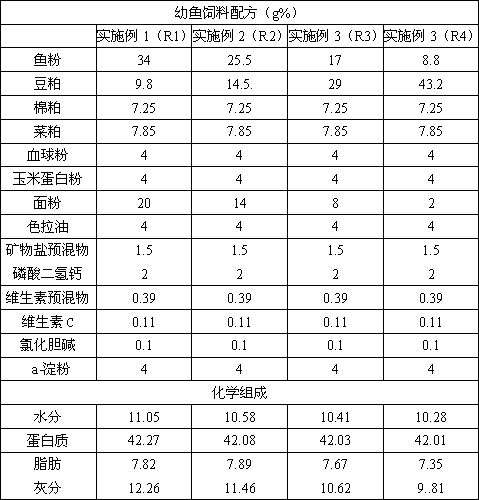Feed proportioning method and cultivation method of juvenile yellow catfish
A technology for juvenile fish feed and breeding method, which is applied to animal feed, animal feed, fish farming and other directions, can solve the problems of high cost, difficulty in reducing feed cost, and high bait cost, and achieves saving feed cost, saving feed, and improving feed. The effect of conversion efficiency
- Summary
- Abstract
- Description
- Claims
- Application Information
AI Technical Summary
Problems solved by technology
Method used
Image
Examples
Embodiment 1
[0018] Example 1 (R1)
[0019] Peeled catfish juvenile feed included 9.8% soybean meal, 34% fish meal, 7.25% cotton meal, 7.85% rapeseed meal, 4.0% blood cell meal, 4.0% corn gluten meal, 20.0% flour, 4.0% salad Oil, 1.5% Mineral Salt Premix, 2.0% Monocalcium Phosphate, 0.39% Vitamin Premix, 0.11% Vitamin C, 0.1% Choline Chloride, 4.0% A-Starch, Guaranteed Yellow Catcher The protein content of fish juvenile fish feed is not less than 42% of the total weight. The method of cultivating yellow catfish is mainly to alternately feed juvenile fish feed with high proportion of animal protein and feed with low proportion of animal protein at intervals. In the whole process, the feed was first fed for 4 weeks, and then the feed was fed for 4 weeks, and the experiment lasted for 8 weeks.
[0020] Before the start of the experiment, the fish were starved for 24 hours, and the temporary fish were mixed, then randomly sampled and weighed, 30 fish were placed in each box, and 4 groups (8 ...
Embodiment 2
[0022] Example 2 (R2)
[0023] Peeled catfish juvenile diet includes 14.5% soybean meal, 25.5% fish meal, 7.25% cotton meal, 7.85% rapeseed meal, 4.0% blood cell meal, 4.0% corn gluten meal, 14.0% flour, 4.0% salad Oil, 1.5% Mineral Salt Premix, 2.0% Monocalcium Phosphate, 0.39% Vitamin Premix, 0.11% Vitamin C, 0.1% Choline Chloride, 4.0% A-Starch, Guaranteed Yellow Catcher The protein content of fish juvenile fish feed is not less than 42% of the total weight. The method of cultivating yellow catfish is mainly to alternately feed juvenile fish feed with high proportion of animal protein and feed with low proportion of animal protein at intervals. In the whole process, the feed in Example 1 was fed for 4 weeks first, and then the feed in Example 2 was fed for 4 weeks, and the experiment lasted for 8 weeks in total.
[0024] Before the start of the experiment, the fish were starved for 24 hours, and the temporary fish were mixed, then randomly sampled and weighed, 30 fish wer...
Embodiment 3
[0026] Example 3 (R3)
[0027] The feed for juvenile yellow catfish included 29.0% soybean meal, 17.0% fish meal, 7.25% cotton meal, 7.85% rapeseed meal, 4.0% blood cell meal, 4.0% corn gluten meal, 8.0% flour, and 4.0% salad Oil, 1.5% Mineral Salt Premix, 2.0% Monocalcium Phosphate, 0.39% Vitamin Premix, 0.11% Vitamin C, 0.1% Choline Chloride, 4.0% A-Starch, Guaranteed Yellow Catcher The protein content of fish juvenile fish feed is not less than 42% of the total weight. The method of cultivating yellow catfish is mainly to alternately feed juvenile fish feed with high proportion of animal protein and feed with low proportion of animal protein at intervals. The whole process was first fed with the feed in Example 1 for 4 weeks, and then fed with the feed in Example 3 for 4 weeks, and the experiment lasted for 8 weeks in total.
[0028] Before the start of the experiment, the fish were starved for 24 hours, and the temporary fish were mixed, then randomly sampled and weighed...
PUM
 Login to View More
Login to View More Abstract
Description
Claims
Application Information
 Login to View More
Login to View More - R&D
- Intellectual Property
- Life Sciences
- Materials
- Tech Scout
- Unparalleled Data Quality
- Higher Quality Content
- 60% Fewer Hallucinations
Browse by: Latest US Patents, China's latest patents, Technical Efficacy Thesaurus, Application Domain, Technology Topic, Popular Technical Reports.
© 2025 PatSnap. All rights reserved.Legal|Privacy policy|Modern Slavery Act Transparency Statement|Sitemap|About US| Contact US: help@patsnap.com


